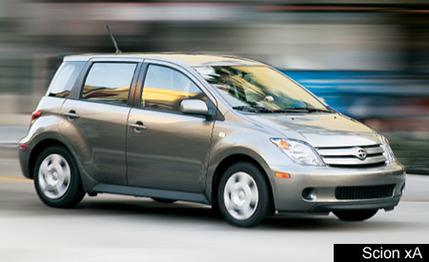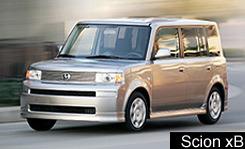 First Drive Review
First Drive Review
Bean or box? Boiled down to its bones, that is the question facing the pioneers who stumble into the first Scion dealerships.
Whoa. Scion? It means "a descendant or offspring." (It's pronounced sigh-on.) And indeed, Scion has sprung from the fertile loins of Toyota as a new cheapie car brand for the young. After all those years harvesting baby boomers with "Oh, What a Feeling!" ads, it turns out their kids won't touch a Toyota, Mom's Toyota, with a 10-foot tattoo stencil (see sidebar).
So here comes Scion to determine--pardon us, dear William--whether that which we call Toyota by any other name will sell as sweet. The initial two cars hit Scion's 105 California showrooms this month. A third, more sporty car arrives in June 2004, by which time Scion will have migrated to the rest of the nation.
Meanwhile, the first two cars, the bean and the box, are two of Toyota's Japanese home-market hatchbacks that share the Toyota Echo's chromosomes. They both have strut and twist-beam suspensions and the Echo's 108-hp, 1.5-liter DOHC 16-valve four-cylinder engine, with variable valve timing on the intake cam.
First, meet the bean. It is the Toyota Ist in Japan and the Scion xA in America, where it leads the freshly printed Scion catalog with a base sticker of just $12,965 on five-speed manual models. The optional four-speed automatic adds $800 to both the xA and the xB.
The 93.3-inch wheelbase of the xA exactly echoes the Echo's and tightly packs seating for five and almost 12 cubic feet of cargo space between its love handles. The bean's only factory options besides the automatic transmission are front side airbags and front and rear curtain airbags, which come as a package for $650.
Much more interesting is the box, especially to pedestrians who may ask things like, "When did Westinghouse get into cars?" and "Where do you put in the bleach?" Japan, which has had three years to get used to all those right angles, knows it as the bB (supposedly, that stands for "best balance"). Here, it will star as the Scion xB and roller-skate out of showrooms on its 15-inch wheels at $14,165 with a stick. It rides on a longer wheelbase than the xA, 98.4 inches, and has more room inside for people and about 21 cubic feet behind the rear seats for clutter.
 The Scion twins are significantly upgraded for duty in America: extra steel reinforcement in their skeletons, more sound-damping material, tighter suspensions, and a substantially longer list of standard accessories. That list includes four-wheel disc brakes with anti-lock in the xA and disc brakes with ABS, traction control, and skid control in the xB.
The Scion twins are significantly upgraded for duty in America: extra steel reinforcement in their skeletons, more sound-damping material, tighter suspensions, and a substantially longer list of standard accessories. That list includes four-wheel disc brakes with anti-lock in the xA and disc brakes with ABS, traction control, and skid control in the xB.
Scions--both the round and rectilinear variety--also come with standard power windows and locks, a first-aid kit, and a Pioneer single-disc CD player singing through six speakers. On paper, at least, the Scions are a roaring value. Only the Hyundai Accent, Kia Rio and Spectra, Saturn Ion, and Toyota Echo and Tacoma pickup have base prices lower than the xA's, but none has anti-lock brakes, air conditioning, and a CD player as standard equipment.
Even so, Scion's managers view the cars as blank canvases for 38 customization accessories. They range from a $49 faux carbon-fiber shift knob to a $595 satellite-radio receiver and include such whimsy as giant-fingerprint door decals and interior mood-lighting strips.
Steered around the Mission District of San Francisco during the Scion's launch, a 2400-pound xA automatic demonstrated a bump-absorbent ride and lightly weighted but lively controls. The seating position is high, just an inch or two less than a Toyota RAV4's, so minivan drivers are almost at eye level. Glass rings the cockpit like a lighthouse, but wind noise and tire moan are reduced to a whisper, thanks to the extra sheets of sound insulation and double-tube door seals.
Considering that the xA has the Echo's power but an extra 280 pounds, it's no surprise that the engine struggles to maintain momentum up S.F.'s legendary hills. At least the automatic is programmed to hold gears on uphill hauls, so there's less hunting for power and little to be found anyway.